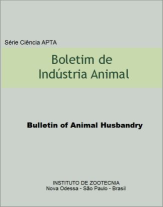Reaction of Rhipicephalus Microplus larvae to potentially repellent substances
Palavras-chave:
Cymbopogon winterianus, Corymbia citriodora, tickResumo
The tick Rhipicephalus microplus is responsible for large losses to cattle breeders due to the problems it causes to host health. The usual form of its control is still based on chemical acaricides that pollute the environment and intoxicate humans and animals. Furthermore, there is the problem of tick resistance to acaricides. For this reason, alternatives to chemical control are needed. Plants such as citronella and eucalyptus have drawn the attention of the scientific community for their acaricidal and repellent potential. The behavior of larvae after hatching is to ascend in the vegetation, forming agglomerates of larvae on leaves and/or stems. The objective of this study was to monitor in vitro the reaction of R. microplus larvae face to potentially repellent substances. This study took place in the Parasitology Laboratory of the Instituto de Zootecnia, Nova Odessa, SP, Brazil. Standard wooden sticks were marked about 3 cm from the tip with a pen and the following treatments were applied up to the pen mark (final third): T1: commercial emulsion of grape seed oil + 6% citronella essential oil (Cymbopogon winterianus, prepared by the company Equilibrio, São Paulo, SP, Brazil); T2: commercial product based on eucalyptus oil (Corymbia citriodora, Coala®); T3: commercial chemical acaricide containing 0.5% citronellal in its formulation (Colosso pour on®); T4: grape seed oil (control 1); T5: soybean oil (control 2) and T6: nothing (control 3). Each stick was introduced into a 10 mL glass vial containing 100 mg of newly hatched R. microplus eggs with the part where the treatment was applied upwards (upper third). For each treatment, 10 replicates were used. The 10 glass vials of each treatment were placed in trays with water, and packed on an open shelf in a ventilated place in the laboratory. The shelf was covered with a cloth, which was moistened at least twice a day. The larvae that were within the marked area (final third of the sticks) were included in a bottle with 70% alcohol on day +19, and counted later. The original data were tested for variance and normality of homogeneity of the distributions, being necessary to eliminate two outliers from T6. The analysis of variance tested the hypothesis of equality between the means of the treatments and showed significant differences (P<0.05). The Tukey test was used to compare the differences between the means of treatments at the 5% level of significance. Statistical calculation was performed by Minitab release 13. The mean numbers of larvae recovered on the upper third of the sticks were: 82.6 ± 6.72; 75.2 ± 5.94; 10.6 ± 3.2; 713.2 ± 19.18; 473.8 ± 12.99; 499.0 ± 32.46 for T1 to T6 treatments, respectively. The sticks with acaricide (T3) had the lowest number of larvae, as expected (P<0.05). There was no significant difference between T1 and T2 (P>0.05), but they were different from the controls (P<0.05). But the highest number of larvae was counted in T4 (grape seed oil) (P<0.05). We concluded that the acaricide, the emulsion with citronella and the eucalyptus oil repelled the larvae, and the grape seed oil attracted them, while soybean oil can be used as a control treatment when studying oily substances in this type of assay.
Downloads
Downloads
Publicado
Edição
Seção
Licença
Os autores não serão remunerados pela publicação de trabalhos, pois devem abrir mão de seus direitos autorais em favor deste periódico. Por outro lado, os autores ficam autorizados a publicar seus artigos, simultaneamente, em repositórios da instituição de sua origem, desde que citada a fonte da publicação original seja Boletim de Indústria Animal. A revista se reserva o direito de efetuar, nos originais, alterações de ordem normativa, ortográfica e gramatical, com vistas a manter o padrão culto da língua e a credibilidade do veículo. Respeitará, no entanto, o estilo de escrever dos autores. Alterações, correções ou sugestões de ordem conceitual serão encaminhadas aos autores, quando necessário. Nesses casos, os artigos, depois de adequados, deverão ser submetidos a nova apreciação. As opiniões emitidas pelos autores dos artigos são de sua exclusiva responsabilidade. Todo o conteúdo deste periódico, exceto onde está identificado, está licenciado sob a Licença Creative Commons Attribution (CC-BY-NC). A condição BY implica que os licenciados podem copiar, distribuir, exibir e executar a obra e fazer trabalhos derivados com base em que só se dão o autor ou licenciante os créditos na forma especificada por estes. A cláusula NC significa que os licenciados podem copiar, distribuir, exibir e executar a obra e fazer trabalhos derivados com base apenas para fins não comerciais.













